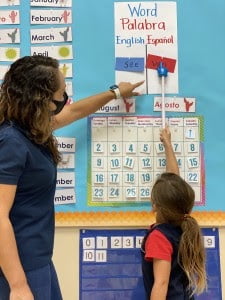You’ve done your research, learned the benefits of early Spanish language learning, and decided to raise your child to be bilingual. If you’re unfamiliar with language immersion schools, chances are you’ll have more than a few questions about Spanish Schoolhouse Fort Worth’s process. You’ve probably been questioned or cautioned by well-meaning friends or family about your plans to teach your young child multiple languages. After all, there are lots of viewpoints about raising bilingual kids and people love to share their opinions!
Awareness is certainly growing about the awesome benefits of bilingualism, but some people still think it’s safer and wiser to let a child master one language before introducing a second. Fortunately, science has proven that many of these common beliefs are actually misconceptions. And with over 20 years of experience at Spanish Schoolhouse, we can confirm this! Here are some of the most common myths we’ve heard at Spanish Schoolhouse Fort Worth over the years.
Bilingual Myth #1- You’ll Confuse Your Child
It’s natural to assume that exposing a young child to two languages at the same time might overload them (especially if they don’t even speak one fluently yet). Many people believe learning a second language will confuse them as they try to make sense of different vocabulary and language structures. They fear this could lead to all kinds of problems. Not so fast!
It’s true that young language learners may mix words from both languages, especially in the early stages. For Spanish-English learners, this may sound like “Spanglish.” The good news is, it’s not a sign of confusion. It’s a linguistic habit called code-mixing. When a child says, “Yo quiero un puppy” or “I want a perrito,” they’re not confused at all. You could even argue that this is the opposite of confusion! They’re simply expressing their wish, and creatively drawing on any words in their repertoire to get it. This video does a good job explaining code-mixing and a related language phenomenon called code-switching.
Bilingual Myth #2: It Causes Speech Delays
The idea that a bilingual learning environment will delay a child’s speech progress is not correct. Most children develop speech skills around the same time they reach vocabulary milestones. If it’s typical for a 2-year old to have a 200-300 word vocabulary, bilingual kids will have the same vocabulary size, but it will be made up of words from both languages. So, yes, for a time, their English vocabulary range may be smaller than that of their peers, but their speaking progress (vocabulary in both languages) will remain on track. And of course, as they develop in both languages, they’ll eventually have double the vocabulary of a single-language peer!
On a similar note, it’s important to assure you that language learning does not cause speech disorders! If a child has an underlying speech disorder, this will show up in both languages and is independent of the multiple language exposure.
Bilingual Myth #3: You Have to be Really Smart to Learn Two Languages
Not so! If you believe this, then half the world must be geniuses! Multilingualism is not unusual. Across the globe, approximately half the population is bilingual. Even in the US, more than one in five people speak more than one language. It’s not hard to find the average, everyday kid speaking 2, 3, or even 4 languages. This ability to communicate so widely is certainly a gift, but kids don’t have to be “gifted” to master it!
Bilingual Myth #4: We Didn’t Start at Birth, We’ve Missed the Bus!
Some people believe that unless a child is born into a multilingual household and immersed from day one, learning new languages will be too difficult for them to ever become truly fluent. Brain science shows there is an early optimal window of learning (generally before the age of 10). But even children who start learning a new language years after they were introduced to their first language can still master it with near-native fluency!

Bilingual Myth #5: Bilinguals Struggle Academically
Actually, the opposite is true. Research shows that bilingual children have cognitive advantages over single-language students. They are more adept at problem-solving, have better cognitive flexibility, and tend to outscore monolingual students in standardized testing. Take a look at the Language Learning FAQs on the Spanish Schoolhouse Fort Worth website for more info and research sources.
The Bottom Line… Is Language Immersion Really Worth It?
Chances are you’re making sacrifices to give your child the gift of bilingualism. It takes time, effort, dedication, and often a financial commitment. However, the doors that will be open to them in the future (career opportunities, cultural understanding, and social interaction) make the answer to this question a resounding YES!
If you’re interested in Spanish Immersion but still have questions and are on the fence, please come visit us at Spanish Schoolhouse Fort Worth for a tour. Our students will dispel the common bilingual myths and show you how well the process works!

